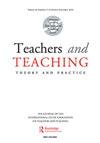给你的教练打分:在教师入职的过程中,探索教练技能的评分
IF 1.9
2区 教育学
Q2 EDUCATION & EDUCATIONAL RESEARCH
引用次数: 0
摘要
摘要本研究旨在探讨新手教师与教练对辅导技巧的评价。在为期两年的项目中,我们每年都会对受访者进行调查,以更多地了解他们的入职经历。我们进行了一系列的t检验,以确定受访者群体之间和随时间的差异,以及多元线性回归,以预测与受访者对教练技能评级相关的特征。本研究结果显示,新手教师认为自己与教练匹配良好的信念,以及教练认为自己对周围支持的信念,分别预测了更高的教练技能评分。此外,新手教师对教练技能的评价高于教练,而且随着时间的推移,所有评分都在增加。研究结果对创建更细致入微的入门课程有启示意义,以更好地支持新手教师发展的教练互动。关键词:教师入职培训教师信念教师发展致谢首先,我们要感谢Tonya Almeida, Barbara Howard和CTI项目的工作人员愿意与整个社区分享他们宝贵的工作。我们要感谢Linda Sanada在整个研究过程中的技术专长和指导。最后,我们要感谢所有的候选人和教练在课堂上孜孜不倦的工作。披露声明作者未报告潜在的利益冲突。Pseudonym.2。CTI教练从这里开始被称为资本“教练”。CTI特别使用Coach这个术语,而不是mentor。这是整个通信和调查中使用的唯一术语,因此,我们在整个手稿中提到的唯一术语。未纳入分析的调查项目包括受访者对技术资源的满意度,这与本研究无关,以及使用的教练活动和策略,这两项调查都不是其中的一部分。可应要求提供调查。下面描述的所有分析也对762个人的完整样本进行了分析。然而,我们相信更可靠的结果源于当前成对个体的分析样本,从中我们可以看到信念随时间变化的更真实的影响。我们承认,运行多个t检验会增加家庭错误的可能性。虽然校正测试可以解释这些错误,但有一些争论认为,这些错误的校正是以增加II型错误为代价的(Armstrong, Citation2014)。此外,这种分析技术在本质上是探索性的,以确定是否有差异的手段。它有助于建立回归的使用,这是一种更精确的方法,可以控制其他变量,以探索被调查者群体在教练技能方面的差异,如下所述。我们认识到在对个别调查项目进行t检验然后将这些项目分解为一个整体结构之间的差异存在研究局限性。然而,由于在所有t检验中几乎一致的显著差异,我们认为教练技能结构代表了这些信念,并且在研究目的上是合理的相似。本材料基于C-1006110和加州大学校董会支持的河滨县学校督学的工作。本出版物中表达的任何观点、发现、结论或建议均为作者的观点,并不一定反映河滨县学校监督或加州大学董事会的观点。本文章由计算机程序翻译,如有差异,请以英文原文为准。
Rate your coach: exploring ratings of coaching skills throughout teacher induction
ABSTRACTThis quantitative study explores novice teacher and coach ratings on coaching skills. Annual surveys were collected from respondents throughout a two-year programme to learn more about their induction experiences. We run a series of t-tests to identify differences between respondent groups and over time as well as multiple linear regressions to predict for characteristics that are associated with respondent ratings of coaching skills. Results from this study indicate that novice teachers’ belief that they were well matched with their coaches as well as coaches’ beliefs about induction complimenting surrounding support separately predicted for higher ratings of coaching skills. Additionally, novice teachers rated their coaches’ skills higher than the coaches did and all ratings increased over time. The findings have implications for creating more nuanced induction programme curricula to better support coaching interactions for novice teacher development.KEYWORDS: Teacher inductioncoachingteacher beliefsteacher development AcknowledgmentsWe first want to thank Tonya Almeida, Barbara Howard, and the CTI programme staff for their willingness to share their invaluable work with the community at large. We want to thank Linda Sanada for her technical expertise and guidance throughout this research. Finally, we would like to thank all Candidates and Coaches for their tireless work in the classrooms.Disclosure statementNo potential conflict of interest was reported by the author(s).Notes1. Pseudonym.2. CTI coaches are termed capital ‘Coach’ from here forward. CTI specifically uses the term Coach instead of mentor. That is the only terminology used throughout communications and surveys, and thus, the only term we refer to throughout this manuscript.3. Survey items not incorporated into analyses include respondent satisfaction with technological resources, which were not relevant to this study, and coaching activities and strategies used, which were not a part of both surveys. Survey is available upon request.4. All analyses described below were also performed with the full sample of 762 individuals. However, we believe more reliable results stem from the current analytic sample of paired individuals, in which we can see truer effects of change of beliefs over time.5. We acknowledge that running multiple t-tests increases the potential for family-wise errors. While correction tests could have accounted for these errors, there is some argument that correction for these errors comes at the expense of increasing Type II errors (Armstrong, Citation2014). Additionally, this analytical technique was exploratory in nature to identify whether there are differences in means. It helps to establish the use of regression, a more precise method that controls for other variables to explore differences in coaching skills by respondent group, described next.6. We recognise the study limitation in the differences between conducting t-tests on individual survey items and then factoring these items towards one holistic construct. However, because of the near consistent significant differences across all t-tests, we believe that the Coaching Skills construct represents these beliefs and is justifiably similar for study purposes.Additional informationFundingThis material is based on work supported by Riverside County Superintendent of Schools under C-1006110 and The Regents of the University of California. Any opinions, findings, and conclusions or recommendations expressed in this publication are those of the author(s) and do not necessarily reflect the views of the Riverside County Superintendent of Schools or The Regents of the University of California.
求助全文
通过发布文献求助,成功后即可免费获取论文全文。
去求助
来源期刊

Teachers and Teaching
EDUCATION & EDUCATIONAL RESEARCH-
CiteScore
4.20
自引率
7.40%
发文量
71
期刊介绍:
Teachers and Teaching: theory and practice provides an international focal point for the publication of research on teachers and teaching, in particular on teacher thinking. It offers a means of communication and dissemination of completed research and research in progress, whilst also providing a forum for debate between researchers. This unique journal draws together qualitative and quantitative research from different countries and cultures which focus on the social, political and historical contexts of teaching as work. It includes theoretical reflections on the connections between theory and practice in teachers" work and other research of professional interest.
 求助内容:
求助内容: 应助结果提醒方式:
应助结果提醒方式:


